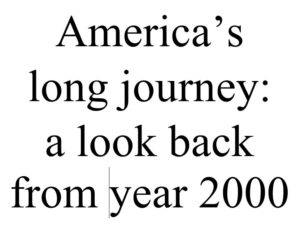
America’s Long Journey: The Bastille and America
We saw it in the 20th century. People’s reaction to the Communist revolution in Russia helped shape, and in turn was shaped by, domestic politics. People divided into sides, and became incapable of really seeing or hearing anything the other side did or said except through mental filters that sorted the world into “us” and “them.” Twentieth-century partisans defined each other as “left-wing” or “right-wing,” and few of them realized that they were echoing the quarrels of the late eighteenth-century. (Even the terms “left” and “right” came from the relative seating positions of French delegates in their national assembly.) That reflexive division seriously damaged the nation’s ability to deal with its problems rationally in the twentieth century, and it wasn’t any different in the republic’s first years.
Everyone knows a few things about the French revolution: its inspiration from the American revolution; the fall of the Bastille; the guillotine; the execution of King Louis XVI and Marie Antoinette; the reign of terror; Napoleon; the Napoleonic wars. But not everyone knows the effect all that had on America. Americans looked on, from their safe distance, and depending on their philosophical and ideological leanings, they were fascinated and hopeful, or disappointed and horrified.
Thus, to conservatives it was a glimpse of the chaos that always lies latent beneath the social order. To liberals, it carried the hope of a world freed of past oppressive forces. Each side saw what it expected to see, and what its mental filters allowed it to see, perhaps forced it to see. There was truth in each view, but the larger truth of the situation – the fact that the world was larger and more complicated than their view of it – escaped the partisans.
Secretary of State Jefferson celebrated the revolution’s republican ideals. As minister to France, he had witnessed the hope-filled beginnings of the revolution, and had been surprised, upon returning home to become Secretary of State, to find his enthusiasm for the cause not universally shared. He began to think that there was an active party seeking to overthrow republicanism and replace it with a regime that would be more authoritarian, if not outright monarchist.
Secretary of the Treasury Hamilton, always an advocate of a strong government to protect society against chaos, naturally suspected the domestic forces that sympathized with the revolution, and supported the British and other forces that were attempting to overthrow the revolution by military force. He pointed to the revolution’s track record.
That record was mixed at best. It was true that the revolution had swept away ancient injustices and outdated remnants of feudalism. But for five years, from the fall of the Bastille in 1789 until the end of the Reign of Terror in 1794, it had became ever more violent, extreme, and unstable. As in any reign of terror, the liberties of the people were swept away, as were institutional buffers, moderation, and tolerance. What remained, behind the fine words, was force.
With the well-deserved execution of Robespierre, the Reign of Terror came to an end, but what had been done could not be undone, and what Americans had witnessed could not be un-witnessed. The Directory that followed the Terror, and Napoleon, who followed the Directory first as First Consul, then as Emperor, could not undo the lasting impressions left by five years of mob rule. Those impressions hardened and strengthened Hamilton and the Federalists, and put Jefferson and the Republicans on the defensive. And, as we have seen, Citizen Genet, trying in his blundering way to bring the guillotine to America, only strengthened the Federalists and weakened the Republicans.
Jefferson and Hamilton became the nuclei around which the Republican and Federalist parties formed. The Republicans called the Federalists the “British party” and the Federalists called them the “French party,” and each exaggerated the other’s blindness and venality, as parties generally do.
Only Washington continued to put his country ahead of ideology. He saw that what was most important was not ideology, nor a matter of preference for one form of society or another. America’s interests were not best served by identifying with another country’s interests, be they French or British. Both powers had to be kept at arms’ length. Especially when the revolutionary wars expanded to include England and Spain in 1793, the United States had to remain neutral for its own protection.
Washington’s reward for his concern for his country’s welfare was to have his name used by the Federalists and abused by the Republicans. But the fact remains: Washington, almost alone among the statesmen of the 1790s, never took his eyes off the ball. For the safety of the fledgling American republic, the balance between France and England had to be maintained.
“America’s interests were not best served by identifying with another country’s interests, be they French or British.” Such good advice, since we continue to be reactionary. I still feel the call of “fraternite, egalite, liberte,” so you can see whose camp I’m in.
Interesting to think of the revolution in light of TGU and Thomas’ reminder that 3D is not the center of it all, though not of lesser value.